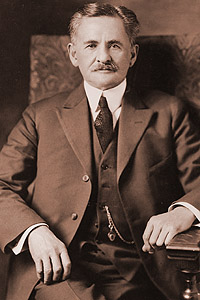Michelson helped build Chicago’s Physics program while pursuing exactitude in his lab experiments
By Steve KoppesNews Office
 Albert A. Michelson | |
On Tuesday, Oct. 9, the Royal Swedish Academy of Sciences will announce the recipients of the 2007 Nobel Prize in physics. This year also marks the 100th anniversary of the first Nobel Prize awarded to an American scientist, University physicist Albert A. Michelson (1852-1931), who measured the speed of light.
It was the first of many Nobel Prizes that Chicago scientists would receive. In fact, two other scientists who later received the Nobel Prize—Robert A. Millikan in 1923 and Arthur H. Compton in 1927—joined the Physics Department faculty during Michelson’s tenure as Chairman.
“In Chicago, Michelson’s Nobel Prize was hailed in banner headlines as a triumph for the city, for the young university, and for the nation as a whole,” wrote Michelson’s daughter, Dorothy Michelson Livingston, in her book Master of Light: A Biography of Albert A. Michelson, published in 1973.
Today, visitors to the Ryerson Physical Laboratory on campus can still see wooden cabinetry high on the ceiling of the first floor that Michelson had designed into the building for one of his experiments. Dedicated in 1894, the Ryerson Laboratory housed the Physics Department until 1985, when it moved into the new Kersten Physics Teaching Center.
“Ryerson Laboratory was built according to Michelson’s instructions,” said Hellmut Fritzsche, the Louis Block Professor Emeritus in Physics and the College. No iron was used anywhere in the building’s construction to prevent magnetic interference with his experiments. “He wanted to do very, very accurate experiments,” Fritzsche said.
Michelson received the Nobel Prize in physics on Dec. 10, 1907, in Stockholm. The Nobel Committee cited Michelson for his precision optical experiments in general, not specifically for measuring the speed of light. “Just to measure the speed of light more and more accurately would not have given him his Nobel Prize,” Fritzsche said.
The U.S. Naval Academy has scheduled a Michelson Centennial Symposium for Oct. 22 in Annapolis, Md. Speakers will include Robert Fefferman, Dean of the Physical Sciences Division and the Max Mason Distinguished Service Professor in Mathematics and the College. Michelson graduated from the Naval Academy in 1873, and taught physics and chemistry there as an instructor from 1875 to 1879.
 Albert A. Michelson and Arthur H. Compton | |
Fritzsche developed a special interest in Michelson’s work while serving as Chairman of the Physics Department from 1977 to 1986. “We have such a wonderful history of great people,” he said. In all, 79 Nobel laureates worked at Chicago as faculty members, researchers or students at some point in their careers, including 27 in physics.
Michelson was born in Strelno, Poland. His family moved to California and then to Nevada while he was still a child. He received a special appointment to the Naval Academy in 1869 after pleading his case in person to President Ulysses S. Grant. Michelson later joined the faculty of what is today called Case Western Reserve University in Cleveland, Ohio.
In Cleveland, Michelson collaborated with Edward Morley on their widely acclaimed ether drift experiment. According to physicists of the day, the ether provided the means for light waves to be transmitted across the vacuum of space, much like air transmits sound through the atmosphere.
Michelson and Morley designed their experiment to measure and compare the speed of light in multiple directions. If the ether did exist, the experiment would show that light moving in the same direction as the Earth was traveling faster than light moving at right angles to it. “That was really a brilliant idea, and important for physics,” Fritzsche said.
In 1887 they published the results of the experiment, which showed no difference in the speed of light in any direction. “In other words, the ether doesn’t exist,” Fritzsche said.
Albert Einstein’s 1905 special theory of relatively assumes the constant speed of light in the vacuum of space. “Many people have said that Einstein based much of his thinking on Michelson’s result of the ether-drift experiment, and that is not so. There’s a long dispute whether Einstein even knew about Michelson’s experiment at the time he formulated his ideas,” Fritzsche said.
Michelson left Cleveland in 1889 for Massachusetts to head Clark University’s Physics Department. But founding President, William Rainey Harper, soon enticed Michelson to come to Chicago to establish a Physics Department at the University.
In 1920, Michelson became the first to measure the diameter of a star other than the sun by attaching an optical device called an interferometer to a telescope. Even today, no one has ever directly measured the diameter of a distant star, Fritzsche said. But Michelson managed the feat indirectly using his interferometer and the 100-inch telescope on Mount Wilson in California to measure the diameter of the giant star Betelgeuse.
At the turn of the century, Michelson had famously stated that there was nothing new for physicists to discover. In his view, there was nothing left but to make ever more accurate measurements of known phenomena. “That, of course, was shown in the 20th century to be very much off the mark,” Fritzsche said.
But it nicely characterizes Michelson’s obsession with exactitude. “I associate Michelson with precision,” he said.
![[Chronicle]](/images/sidebar_header_oct06.gif)